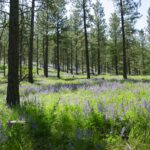The American Forest Resource Council (ARFC) and other members of the North Central Washington Forest Health Collaborative (NCWFHC) recently toured the Upper Wenatchee Project (UWP) on July 23rd to review landscapes, root disease impacts, chipping objectives, commercial thinning samples, protection fire lines and other important items near the Wolverine community protection fire line and the Ponderosa Pine Plantation, as well as the Lower Chiwawa River area.
Through partnership with the NCWFHC, in 2017, the Okanogan-Wenatchee National Forest (OWNF) received approximately $1.6 million dollars to pilot collaborative restoration and hazardous fuels reduction work. The UWP is a direct response to the call for greater investments in high wildfire risk communities from more than 400 community members who participated in the Wildfire and Us Summit following the 2015 wildfire season.
The UWP, covering nearly 75,000 acres near Lake Wenatchee, WA. The primary focus of the UWP is to restore forest health and resiliency by reestablishing forest structure, returning fire to the landscape, improving wildlife habitat, and improving watershed function.
During the field trip, participants learned from Bill Burgess about challenges with reliable materials flow due to the shift from larger-to smaller-diameter trees, and how chipping can help achieve a blend of economic and restoration objectives through use of smaller-diameter materials.
OWNF staff, OWNF staff, AFRC and NCWFHC members also reviewed the importance of blending forest health restoration treatments with species selection, wildlife habitat needs and in-stand resilience traits such as disease and fire resilience on their tour.



